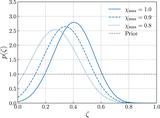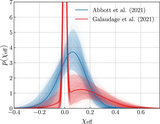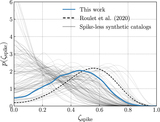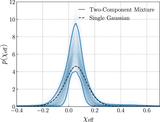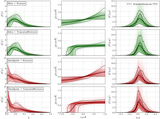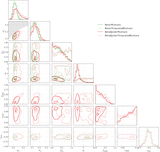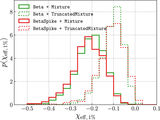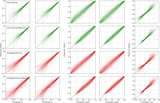Image Details

Caption: Figure 14.
Left panel: the probabilities p NS for each binary black hole in GWTC-2 to be nonspinning, as computed in two different ways: through a Savage–Dickey density ratio and using fully marginalized likelihoods computed via nested sampling and reported in Abbott et al. (2021c). The circles denote GW190408_181802 and GW190828_063405, whose nested sampling results appear to be outliers. Center panel: the spin magnitude posterior for GW190408_181802. Nested sampling yields a Bayes factor of ﹩{{ \mathcal B }}_{{\rm{S}}}^{\mathrm{NS}}\sim 130﹩ in favor of the hypothesis that this event is nonspinning. This would require the spin magnitude posterior to be ∼130 times larger than the (flat) prior at χ 1 = χ 2 = 0. This is inconsistent, though, with the true posterior on the spin magnitudes of GW190408_181802, suggesting that the nested sampling Bayes factor in favor of the nonspinning hypothesis is significantly overestimated. Right panel: as a consistency check, we repeat the counting experiment from Section 3 using the nested sampling Bayes factors serving as input to Galaudage et al. (2021), rather than our Savage–Dickey estimates. We show posteriors obtained using the entire GWTC-2 catalog (solid blue curve) and results after excluding GW190408_181802 from our sample (dashed blue). As mentioned in Section 3, we obtain much closer agreement with the Savage–Dickey result (gray curve) after excluding GW190408_181802.
Copyright and Terms & Conditions
© 2022. The Author(s). Published by the American Astronomical Society.


